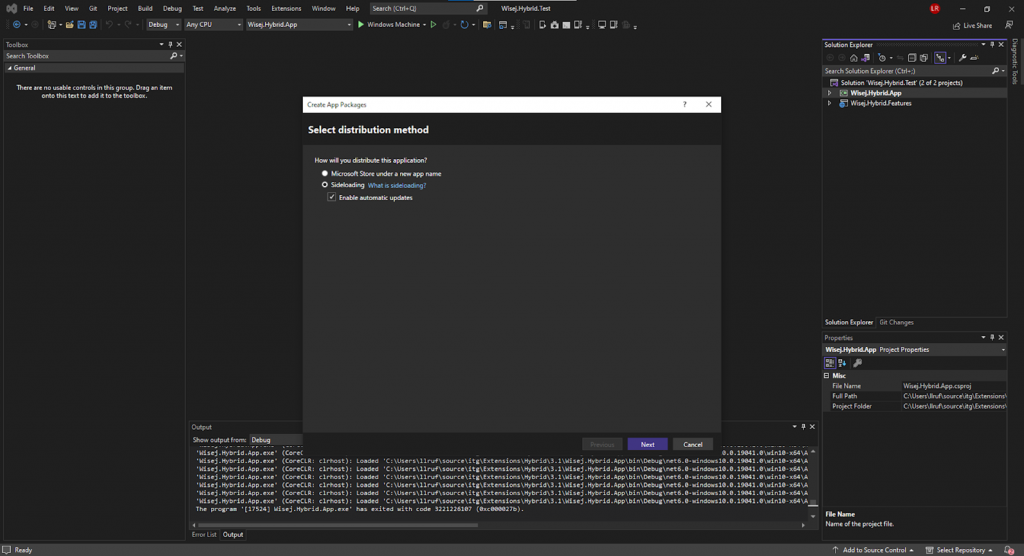Looking back at 2022, it’s been a year of change. The release of Wisej.NET 3 was very well received and it brings Enterprise-scale Web Development to a new level. Our team has grown and we are investing in marketing and product development. At the same time, we see an increasing demand for Desktop to Cloud migrations. We are working on a number of international projects, together with our partners.
Before we leave for a short season break, we wanted to reach out with a warm Thank You to all of our clients, partners, and employees. It is a great pleasure to work with you! Thank you for your commitment and support!
As an early Christmas present, we wanted to share some news from our Roadmap for 2023.
Wisej.NET Hybrid is a new product offering scheduled for Wisej.NET 3.5 in 2023 that will unify and expand upon Wisej.NET Mobile, Wisej.NET Standalone (Desktop), and Wisej.NET Self-Hosting. The hybrid framework will provide developers tools to build and deploy hybrid native / web apps for Windows, macOS, Android, and iOS.

Wisej.NET Hybrid apps will include a variety of features including offline support, native device integrations, extensibility for integrating custom features, and enterprise options for deployment. The hybrid apps can be built and debugged entirely using Visual Studio for Windows and Visual Studio for macOS.
One of the most requested features for Wisej.NET has been the ability to run in an offline environment on every platform. Until this point, this was only possible using Wisej.NET Self-Hosting.
With Wisej.NET Hybrid, apps for every platform can optionally run in an offline environment. When the network connectivity changes for the client device, it will automatically switch to an offline version of the Wisej.NET application (either the same app or a different app) and use a local database. When the device reconnects to the online version of the application, it can synchronize with the local database.
Wisej.NET Hybrid apps will be able to access native device features such as the camera, document scanner, tabbar, toolbar, navigation bar, and more.
Example Usage:
Device.Flyout.Visible = true;
Device.Flyout.Items = new FlyoutItem[] {
new FlyoutItem(“Home”, Images.Home),
new FlyoutItem(“Profile”, Images.Profile),
new FlyoutItem(“Home”, Images.Settings)
};
And attaching to an item selection event:
Device.Flyout.ItemSelected += Flyout_ItemSelected;

Based on today’s plans for integrations, Wisej.NET Hybrid will be able to access:
Since Wisej.NET Hybrid is built around .NET MAUI, it can be used to show native ContentPages in MAUI modally.
Example Usage in Wisej.NET:
Device.Views.Show(“MyContentPage”, args);

The result of some operation on the native view can be fired back to Wisej.NET from MAUI:
Example Usage in a .NET MAUI ContentPage:
App.FireModalResponse(new DeviceResponse(“Some Result”));
The list provided above is a baseline for features that can be integrated into Wisej.NET Hybrid apps. Any new .NET MAUI or platform-specific feature can be wrapped into Wisej.NET Hybrid apps using the interfaces exposed by the Device singleton.
Wisej.NET Hybrid apps can be deployed as any traditional .NET MAUI app would be directly in Visual Studio.


Apps can be deployed manually (i.e. downloading a file from a URL), or through a private feed.
Enterprise Deployment Options:
Wisej.NET Hybrid will be a great step for the future evolution of Wisej.NET. The current state of development is already very promising. The final availability is scheduled for Q3/2023, but with the stability and maturity already in place, we will be able to use it in early adoption projects much sooner.
If you have any questions about Wisej.NET Hybrid or would like to be one of the first users to give it a try, please contact sales@wisej.com.
Caveat: Information shared in this post is preliminary and may change without notice. More details will be provided as part of the beta and release announcements later in 2023.